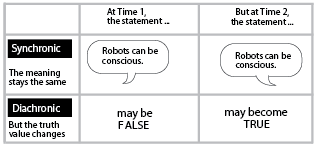Diachronic and synchronic linguistics
The truth value of statements can change over time as word use changes, even though the meaning of such statements remains constant. Statements that are now false under synchronic linguistics may becomme false as revealed by diachronic linguistics.
Hilary Putnam (1962).

Synchronic linguistics: the study of language at a given time.
Diachronic linguistics: the study of language through time.
The truth value of statements (e.g., "Robots can be conscious" or "Pain is identical with stimulation of C-fibers") can be effected by a change of use over the course of time, without a change of meaning in the terms involved. Statements that are now false under synchronic linguistics (the study of language at a given time) may become false, as revealed by diachronic linguistics (the study of language through time).
The Putnam argumentPutnam argues as follows:
"(1) Pain is identical with stimulation of C-Fibers....There is nothing wrong with trying to bring linguistic theory to bear on this issue, but one must have a sufficiently sophisticated linguistic theory to bring to bear. The real question is not a question in synchronic linguistics but one in diachronic linguistics, not 'Is (1) now a deviant sentence ?' but 'If a change in scientific knowledge (e.g. the development of an integrated network of psychophysical laws of high "priority" in our overall scientific world view) were to lead to (1)'s becoming a non-deviant sentence, would a change in the meaning of a word necessarily have taken place?'--and this is not so simple a question" (H. Putnam, 1960, p. 377).
References
Putnam, Hilary. 1975. Minds and Machines.
Mind, Language, and Reality: Philosophical Papers, vol. 2. Cambridge: Cambridge University Press. pp. 362-386. Originally in (1960)
Dimensions of Mind, edited by Sidney Hook. New York: New York University Press.